- Home
- Military & Defense
- Coca production is booming in Colombia - here's how it gets turned into cocaine
Coca production is booming in Colombia - here's how it gets turned into cocaine
Edgar cleans a barrel as his father, Gonzalo, stands next to him.

Coca paste ready for sale sits in the kitchen of a home in Antioquia. Later, at some point along the way, the paste is made into cocaine that is eventually sold on the streets of such places as New York and Amsterdam for many thousands of dollars.
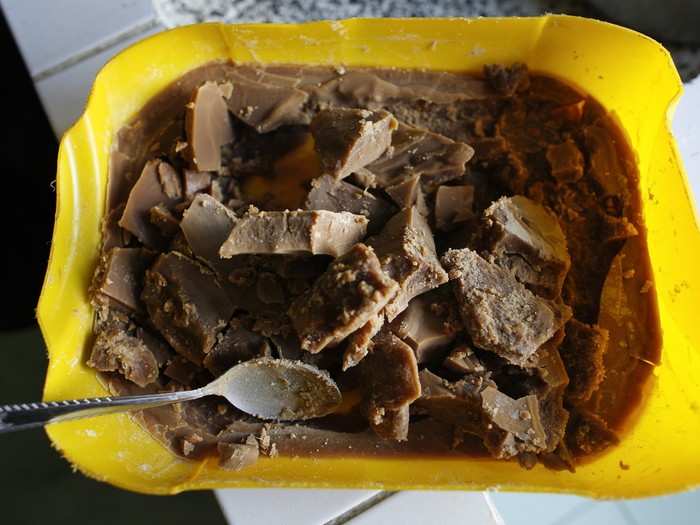
Gonzalo cuts coca paste into pieces ready to sell while his wife observes at their home. Gonzalo says he gets about $900 for a kilo of finished coca paste.
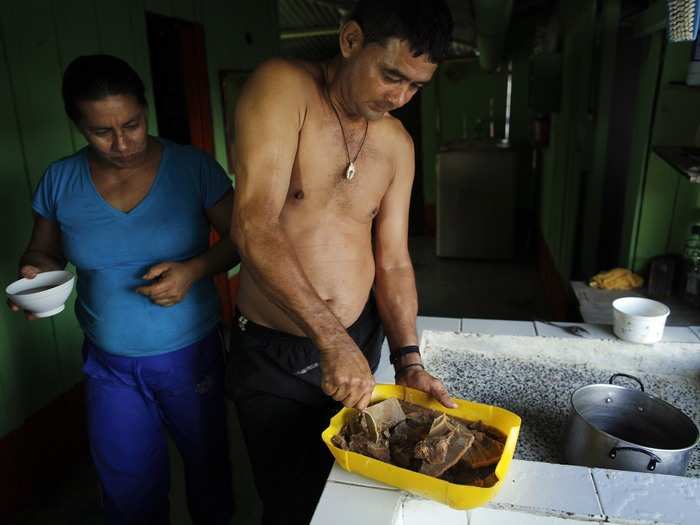
The US has pressured Colombia over the increase in coca cultivation. The White House said in September that it "seriously considered designating Colombia as a country that has failed demonstrably to adhere to its obligations under international counternarcotics agreements" due to the increase.
That statement was greeted with criticism, and Colombian President Juan Manuel Santos responded by saying, "No one has to threaten us to confront this challenge."
While his granddaughter watches, Gonzalo pours liquid of coca-paste residue after cooking it in his kitchen. Once the yellow paste is cooked to evaporate the chemicals and water content, it's crushed to be packed and sold.
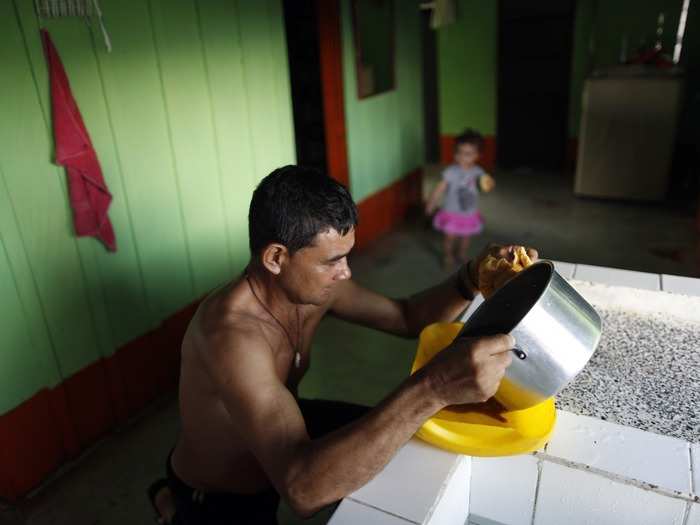
The US Coast Guard has struggled to intercept drug shipments at sea, even when it knows where they are.
"We have good intelligence on between 80% and 90% of these movements," said Vice Adm. Charles Ray during Senate testimony in September, referring to trafficking in the eastern Pacific Ocean and Caribbean. "So we have good intelligence, [but] we only have the capacity to get after about 30% of those" shipments.
Gonzalo cooks coca paste in the kitchen of his house as his daughter-in-law Valeria looks on. This last step is called "fritada," or "fry-up." The coca paste residue is placed in water and heated until most of the water content is evaporated.
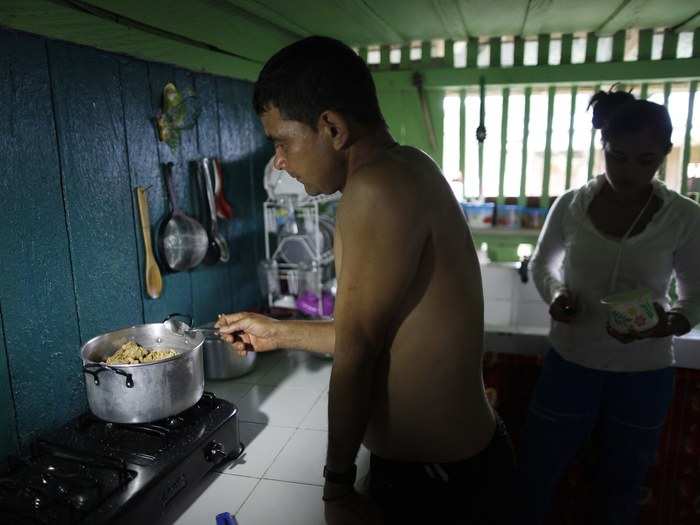
Cocaine is smuggled to the US a variety of ways. It can travel by sea on anything from small crafts called pangas to commercial fishing vessels to homemade submarines. Smugglers also make use of light aircraft to move the drugs from Colombia to Central America, where it is taken into Mexico and eventually to the US.
Gonzalo illuminates a spoonful of liquid coca paste with a flashlight as he cooks it to remove the water content, working in the kitchen of his home. He uses the flashlight because there is no electricity in his house.
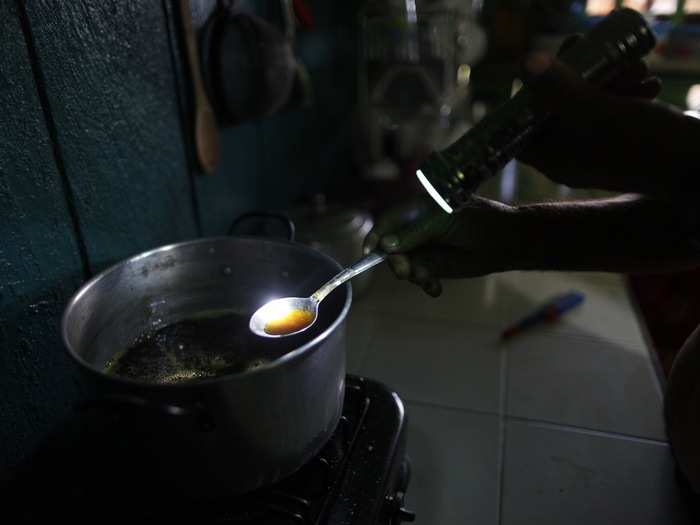
Los Urabeños has been behind some of Colombia's biggest cocaine seizures.
In May 2016, Colombian police seized nearly 9 tons of cocaine worth $240 million hidden near the border with Panama, believed to belong to the group. It was called the biggest seizure in Colombian history, but only three people were arrested in the operation.
Edgar holds a mixing stick with lumps of solidifying coca paste. The paste is extracted after adding a strong acid into the mix that will further precipitate the alkaloid.
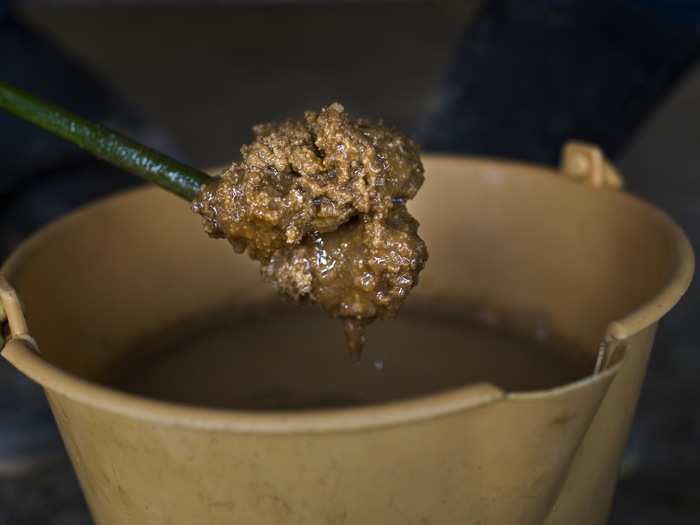
The most prominent Bacrim is known as Los Urabeños and is thought to be the only such group with a truly national reach.
The Colombian government has increased pressure on Los Urabeños, arresting and killing some key operatives, though many of its leaders remain on the run. The group has retaliated, offering bounties for police officers and reportedly paying nearly $700 for each one killed.
A vat holds liquid called "nata," which means buttermilk. The mixture of coca-leaf juice, gasoline, ether, and other chemicals will eventually be converted into coca paste.
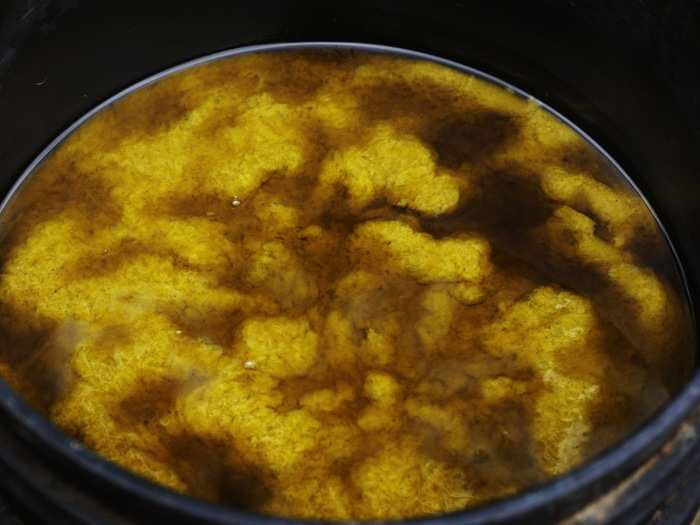
Colombia's various criminal groups — called Bacrim, which is short for the Spanish name "bandas criminales" — have also tried to fill the void left by a demobilized FARC. The increase in coca cultivation over the last three years has bolstered these groups' income, and they, along with dissident FARC members, have contributed to an increase in violence in some parts of the country, especially against leftists and other social and community leaders opposed to criminal activities.
Coca extract is mixed with gasoline during the production of coca paste. Gasoline is used to extract alkaloid from the liquid mix.
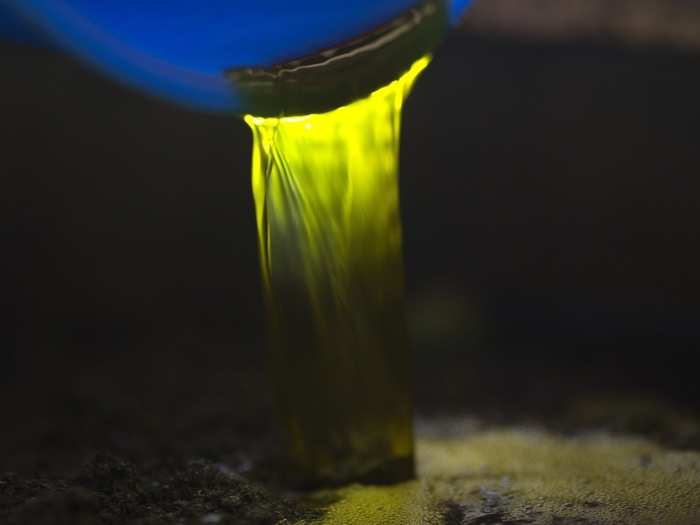
During negotiations, some FARC members rejected the peace process and vowed to carry on with their fight and criminal involvement. The deal initially failed to get public approval in a national plebiscite, heightening fears about FARC recidivism, but Colombia's legislature ultimately approved the accord. Now dissident FARC members are thought to number about 500 former rebels organized in 16 independent factions.
Edgar mixes liquid coca paste with a mask on because it can be hard to breathe amid the noxious fumes that emanate from various buckets marinating the huge mix of leaves.

In 2015, 81% of coca cultivation was concentrated in five of Colombia's 32 departments: Nariño, Cauca, Putumayo, and Caquetá, all of which in are in southern Colombia, and in Norte de Santander, which borders Venezuela in northeast Colombia.
All those areas are affected by armed conflict (Putumayo especially) and frequently appear on the UN Office on Drug and Crime's list of drug-production areas.
Valeria and her husband share a plate as they eat lunch near a laborer stirring a concoction of coca-leaf extract and cement mixed with gasoline. Noxious fumes emanating from the mixture are a normal part of the manufacturing process.
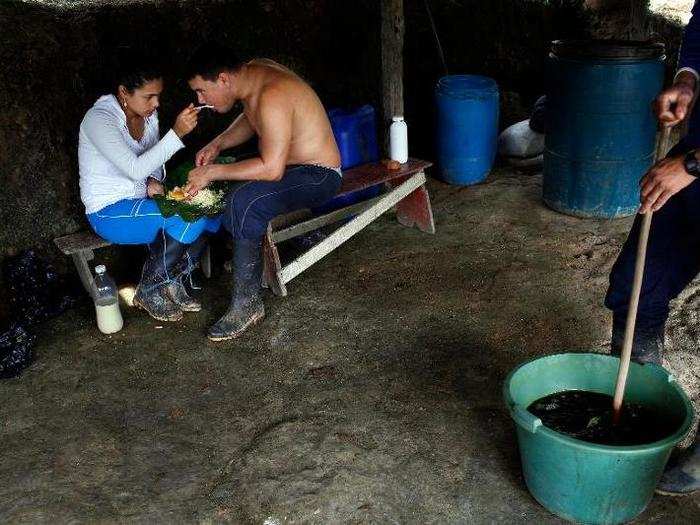
The cultivation increase stems from a number of factors. FARC rebels encouraged farmers to grow it during peace talks, promising they'd be eligible for more subsidies after the deal was concluded. The price of gold has also fallen, making mining less appealing.
Ending eradication by aerial fumigation, which was halted in 2015 over concerns about health risks, appears to have played less of a role in the cultivation increase than thought.
Gonzalo places mulched coca leafs sprinkled with cement and soaked in gasoline into a press as he makes coca paste. The mixture is put into a press so the basic liquid extract of coca paste can be squeezed out.
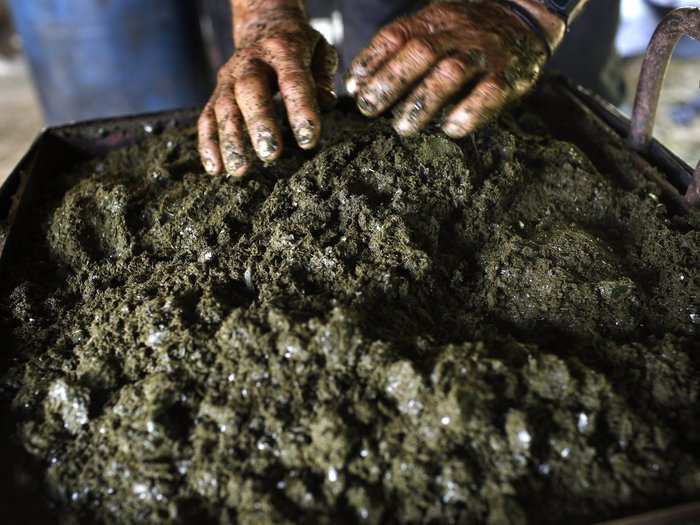
It takes about a ton of coca leaves to make a kilo — about 2.2 pounds — of the paste. That amount of leaves costs a few hundred dollars, and the family can sell a kilo of paste about $900.
That sale is the first in a long series of transactions. The prices increase at each step in the process, going from a few hundred to a few thousand dollars. By the time it's sold on the streets, a kilo can go for more than $100,000, depending on where it's sold.
Gonzalo stirs a mix of mulched coca leaves and cement with gasoline, as part of the initial process to make coca paste. Apart from gasoline and cement, ammonia, sulfuric acid, sodium permanganate, and caustic soda are some of the chemicals used to produce the paste.

Coca helps give local residents "a way of sustaining their families in every sense," in a way that the government hasn't matched, Ferin Oviedo, a representative of the Guayabero Regional Farmers' Association, told Reuters.
A laborer siphons gasoline as Edgar, left, holds a bucket during the production of coca paste. Coca leaves are mixed in big vats that contain gasoline, ether, and other chemicals into a kind of yellow brew.
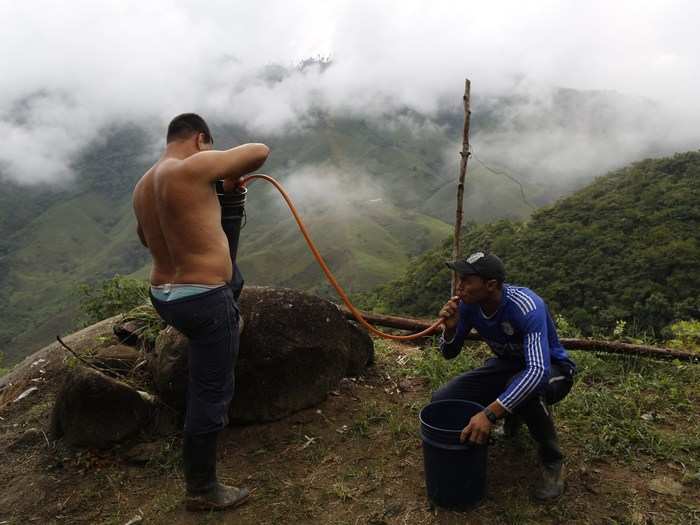
"The government does not want to resolve the huge problem we have here," Orlando Castilla, president of the Farmers Association in the Guaviare region of south-central Colombia, told Reuters in mid-2016. "We appear to be rich, millionaires on a national and international level, but we have nothing to live off," he added.
Gonzalo sprinkles cement over mulched coca leaves to prepare them to make coca paste. The cement is used as a binding agent on the mulched leaves.
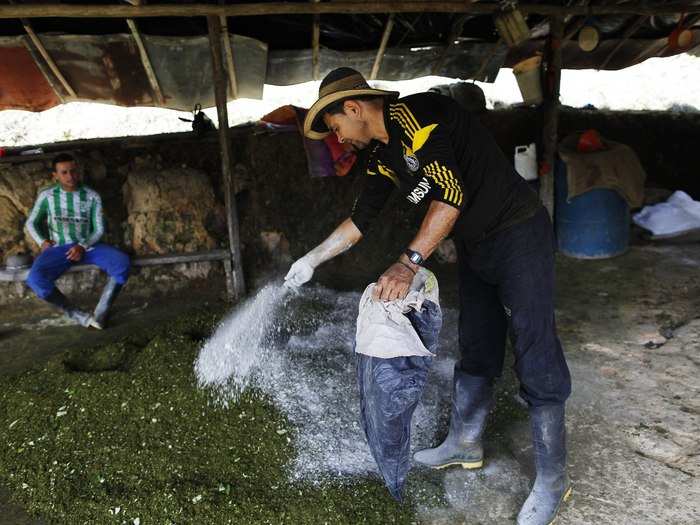
For farmers in remote regions of Colombia, by the time they produce and ship legal crops like fruit to market, their costs will have often exceeded their profits. "But with coca," Jeremy McDermott, codirector of Insight Crime, told The Atlantic, "the buyer will come to your house."
Edgar mulches coca leaves with a weed eater as the first step in making coca paste at a small makeshift lab in Antioquia, January 6, 2016. Next to him the laborers who harvested the leaves eat their breakfast.
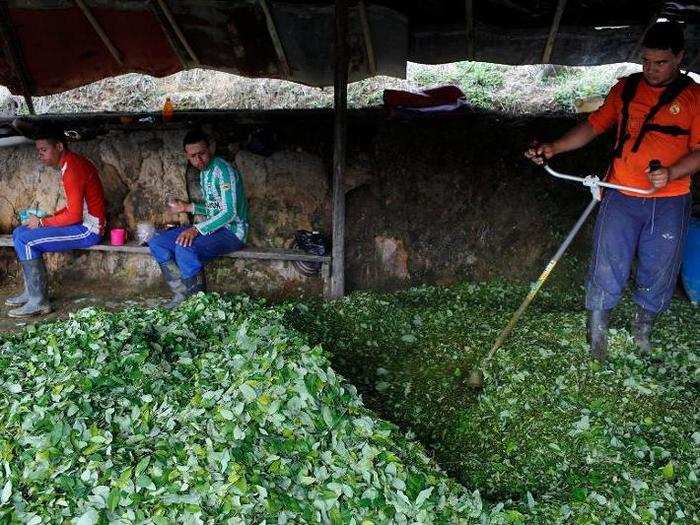
A struggling legal economy — and a dearth of alternatives presented by the government — have contributed to the increase in coca production in Colombia, which now outstrips that of the second- and third-biggest producers combined. The Colombian government's lack of follow-through on crop-substitution programs and failure to offer alternative development projects have earned protests from coca farmers.
Gonzalo's whole family lives off the production of coca paste and are threatened by the idea of coca eradication. "We will confront anyone who touches our plants," said Fernando Zapata, the communal president of the village. "They want to do away with the livelihood of our families and the entire region."

For farmers like those the AP talked to, coca production is less of a moneymaking scheme that a financial imperative. Some Colombian farmers, rather than dealing directly with traffickers, trade their coca paste to local stores in exchange for much-needed goods.
Despite cocaine's reputation for decadence, the production process is relatively simple and crude. Farmers, sometimes families aided by neighbors, pick leaves by hand and put them through a complex and noxious process to eventually turn the leaves into paste, which can then be sold to traffickers.

The territory that Edgar's farm is in was controlled by the FARC before the rebel group agreed to demobilize. At one point the FARC controlled 70% of Colombia's coca crops.
Coca plants grow just two months a year amid the lush greenery of the Colombian countryside. Below, a coca field owned by Edgar and his father, Gonzalo, stands ready for harvest in the mountain region of Antioquia, Colombia, January 7, 2016.
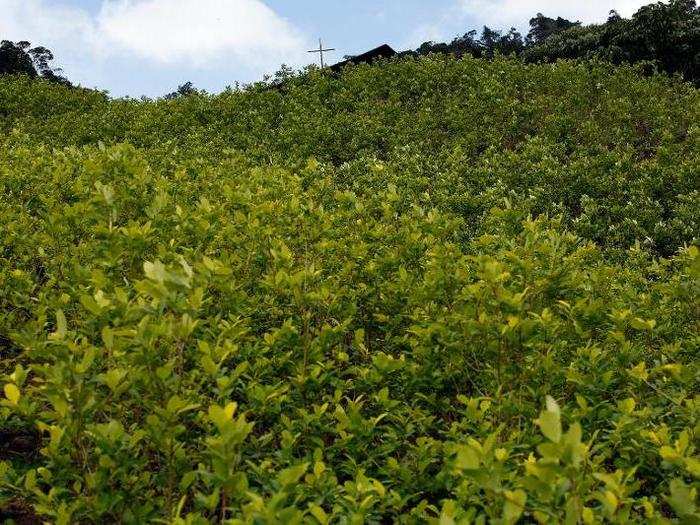
Edgar and his family, who live in Antioquia in northwest Colombia, run a small coca-paste-production operation, a minor cog the the Colombian cottage industry that produces cocaine for world consumption
Popular Right Now
Popular Keywords
Advertisement